The Trump administration wants to dismantle the agency overseeing 2 million federal workers – and weaken safeguards against partisanship
The U.S. government has put expertise and competence ahead of political considerations when it hires people for more than 135 years.
As a result of changes made during President Chester Arthur’s administration, the vast majority of government jobs can only be awarded on the basis of merit. Prospective employees historically had to complete a competitive exam and today must complete detailed applications, undergo interviews and get their background checked. Employees also cannot be fired or demoted for political reasons.
These rules apply to all but about 4,000 politically appointed employees among the 2 million people who work for the federal government, not counting postal service workers. Those only require presidential support and, for around 1,200 of these jobs, Senate confirmation.
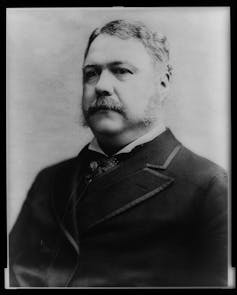
The Trump administration is taking several steps that could remove safeguards against partisanship and nepotism in the federal workforce. Among other things, it is pushing to dissolve the Office of Personnel Management, which oversees the administration of the civil service system. Democrats are objecting to this move.
How The Conversation is different: We explain without oversimplifying.
As a public administration researcher, I look at how political partisanship influences the relationship between government employees and elected officials.
To understand why scholars like me and other experts are concerned that dismantling OPM could harm the civil service system by making it more partisan, it is helpful to understand why the U.S. moved toward a merit-based system in the first place.
To the victor goes the spoils
For about a century following independence from Britain, the U.S. federal workforce operated under a patronage system. Also called the spoils system, it gave elected politicians complete control over the federal workforce, allowing them to dole out government jobs to their most ardent supporters and remove partisan foes.
The political party in power profited directly from the spoils system because a portion of every appointee’s paycheck would be earmarked as a mandatory campaign contribution. By the late 1870s, these mandatory contributions accounted for three-quarters of all campaign contributions.
This emphasis on political loyalty meant that numerous federal employees were either unqualified, unethical or both. Federal government employees were implicated in many bribery scandals, involving everything from regulating railroads to overseeing the whiskey business to awarding contracts for trading posts at military forts.
Even so, members of both major political parties tried to reform the spoils system but were largely unsuccessful until a tragedy brought about change.
An assassination spurs reform
Charles J. Guiteau, a man who by many accounts was suffering from mental illness, shot President James Garfield on July 2, 1881. Garfield soon died from infections related to the gunshot wound.
Guiteau was furious over being denied a federal job despite his perception that he had personally helped Garfield win. The assassination led to a public outcry and widespread demands for personnel reforms.
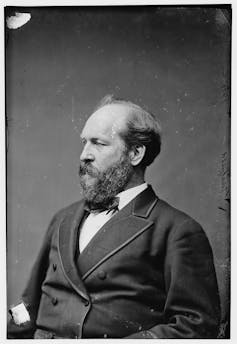
A bipartisan legislative majority passed the Pendleton Act in 1883. The law established open competitive exams for most government positions. The goal was to ensure that civil servants were capable of doing their jobs, while letting presidents retain the ability to appoint the most senior positions. That same system remains largely in place today, administered by three agencies since 1978.
Not down with OPM
One of those three agencies is the Office of Personnel Management, which the Trump administration wants to dismantle and then move its civil service functions elsewhere. Most of the agency’s responsibilities would land within the General Services Administration, which currently oversees the government’s real estate and procurement.
House Democrats and federal labor leaders want to block the move. They say it is unwarranted and could inject partisanship into the federal hiring process – meaning that members of the party in the White House would get the bulk of all new civil service jobs.
OPM is an independent federal agency overseen by Congress. Heads of independent agencies are appointed by the president and confirmed by the Senate, but unlike Cabinet members, they cannot be fired without cause. This makes them more autonomous than other executive branch agencies and partially insulates them from presidential directives.
The Office of Management and Budget, which would take over the administration of federal workforce policy if OPM no longer exists, is an executive branch agency under the president’s direct control. Under this arrangement, Trump could potentially exert more influence over those policies, which he has already shown a willingness to do.
In May of 2018, President Trump issued three executive orders designed to make it easier to fire federal employees and limit the power of federal labor unions. A federal judge blocked the orders a few months later, but some agencies are still trying to independently implement the changes.
More grievances
The three-seat U.S. Merit Systems Protection Board is another agency that grew out of the Civil Service Commission. It is charged with adjudicating employee grievances within the civil service system and has lacked a quorum since a few weeks before Trump took office in January 2017. It has a backlog of more than 2,100 cases waiting to be heard.
The term of its last remaining member, Mark Robbins, expired in March 2019. All board positions have been vacant since then, pending Senate approval of Trump’s three nominees.

The Federal Labor Relations Authority, the third agency that grew out of the Civil Service Commission, administers labor-management relations for non-postal service federal employees. In June 2019, a union representing more than 8,000 Environmental Protection Agency employees filed a grievance with the authority over the Trump administration’s plans to limit telework to one day a week and make it easier to fire EPA staff. The workplace changes are similar to those included in executive orders Trump had signed but which got tied up in court.
In addition to dismantling OPM, the Trump administration plans to relocate a total of about 550 jobs at two Washington, D.C.-based U.S. Department of Agriculture research agencies to Kansas City.
Even before the USDA announced the new workplace site in June 2019, giving these researchers one month to decide whether to move to Kansas City, many had resigned. Some staff members have argued that the reorganization is a form of retaliation against the researchers for their findings that are sometimes at odds with Trump administration policies on issues, such as the degree to which Supplemental Nutrition Assistance Program benefits – also known as food stamps – help millions of Americans.
The official rationale for the move is that it will cut costs.
Trump revived Andrew Jackson’s spoils system, which would undo America’s 138-year-old professional civil service
The federal government’s core civilian workforce has long been known for its professionalism. About 2.1 million nonpartisan career officials provide essential public services in such diverse areas as agriculture, national parks, defense, homeland security, environmental protection and veterans affairs.
To get the vast majority of these “competitive service” jobs – which are protected from easy firing – federal employees must demonstrate achievement in job-specific knowledge, skills and abilities superior to other applicants and, in some cases, pass an exam. In other words, the civil service is designed to be “merit-based.”
It wasn’t always so.
From Andrew Jackson until Theodore Roosevelt, much of the federal workforce was subject to change after every presidential election – and often did. Known as the spoils system, this pattern of political patronage, in which officeholders award allies with jobs in return for support, began to end in the late 19th century as citizens and politicians like Roosevelt grew fed up with its corruption, incompetence and inefficiency – and its role in the assassination of a president.
The Conversation is a news organization dedicated to facts and evidence
Less than two weeks before Election Day, Donald Trump signed an executive order that threatens to return the U.S. to a spoils system in which a large share of the federal government’s workforce could be fired for little or no reason – including a perceived lack of loyalty to the president.
While President Joe Biden appears likely to reverse the order, its effects may not be so easily undone. And he may have his own reasons for keeping it temporarily in place.
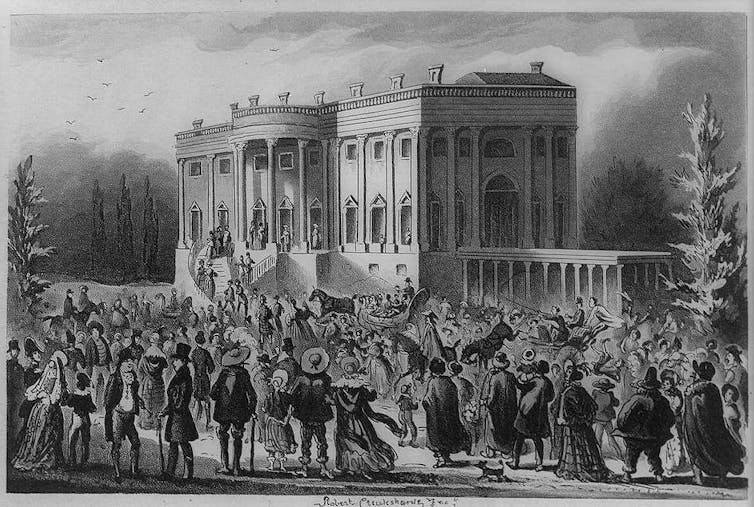
Birth of the spoils system
The government of the early republic was small, but the issue of whether civil servants should be chosen on the basis of patronage or skills was hotly debated.
Although George Washington and the five presidents who followed him certainly employed patronage, they emphasized merit when making appointments.
Washington wrote that relying on one’s personal relationship to the applicant would constitute “an absolute bar to preferment” and wanted those “as in my judgment shall be the best qualified to discharge the functions of the departments to which they shall be appointed.” He would not even appoint his own soldiers to government positions if they lacked the necessary qualifications.
That changed in 1829 when Andrew Jackson, the seventh president, entered the White House.
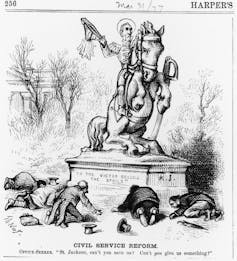
Jackson came to office as a reformer with a promise to end the dominance of elites and what he considered their corrupt policies. He believed that popular access to government jobs – and their frequent turnover through a four-year “rotation in office” – could serve ideals of democratic participation, regardless of one’s qualifications for a position.
As a result, at his inaugural reception on March 4, a huge crowd of office seekers crashed the reception. Jackson was “besieged by applicants” and “battalions of hopefuls,” all seeking government jobs.
Instead of preventing corruption from taking root, Jackson’s rotation policy became an opportunity for patronage – or rewarding supporters with the spoils of victory. He defended the practice by declaring: “If my personal friends are qualified and patriotic, why should I not be permitted to bestow a few offices on them?”
Besides possessing a lack of appropriate skills and commitment, office seekers were expected to pay “assessments” – a percentage of their salary ranging from 2% to 7% – to the party that appointed them.
Although Jackson replaced only about 10% of the federal workforce and 41% of presidential appointments, the practice increasingly became the norm as subsequent presidents fired as well as refused to reappoint ever-larger shares of the government.
The peak of the spoils system came under James Buchanan, who served from 1857 to 1861. He replaced virtually every federal worker at the end of their “rotation.” William L. Marcy, who was secretary of state under Buchanan’s predecessor and was the first to refer to patronage as “spoils,” wrote in 1857 that civil servants from his administration were being “hunted down like wild beasts.”
Even Abraham Lincoln, who followed Buchanan, made extensive use of the system, replacing at least 1,457 of the 1,639 officials then subject to presidential appointment. The number would have been higher but for the secession of Southern states, which put some federal officials out of his reach.
A ‘vast public evil’ comes to an end
The tide began to turn in the late 1860s following public revelations that positions had been created requiring little or no work and other abuses, including illiterate appointees, and a congressional report about the success of civil service systems in Great Britain, China, France and Prussia.
In 1870, President Ulysses S. Grant asked Congress to take action, complaining, “The present system does not secure the best men, and often not even fit men, for public place.” Congress responded with legislation that authorized the president to use executive orders to prescribe regulations for the civil service. That power exists today, most recently exercised in Trump’s own order.
Grant established a Civil Service Commission that led to some reforms, but just two years later a hostile Congress cut off new funding, and Grant terminated the experiment in March 1875. The number of jobs potentially open to patronage continued to soar, doubling from 51,020 in 1871 to 100,020 in 1881.
But across the U.S., citizens were becoming disgusted by a government stuffed with the people known as “spoilsmen,” leading to a growing reform movement. The assassination of President James Garfield in 1881 by a deranged office seeker who felt Garfield had denied him the Paris diplomatic post he wanted pushed the movement over the edge.
Garfield’s murder was widely blamed on the spoils system. George William Curtis, editor of Harper’s Weekly and an advocate for reform, published cartoons lambasting the system and called it “a vast public evil.”
In early 1883, immediately after an election that led to sweeping gains for politicians in favor of reform, Congress passed the Pendleton Act. It created the Civil Service System of merit-based selection and promotion. The act banned “assessments,” implemented competitive exams and open competitions for jobs, and prevented civil servants from being fired for political reasons.
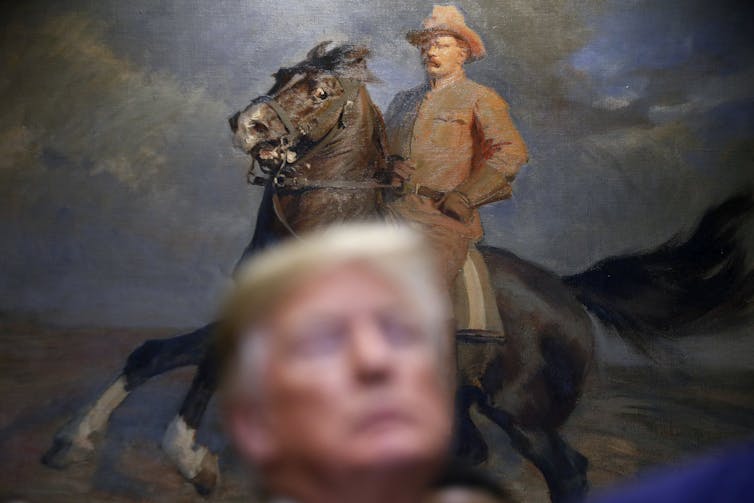
Roosevelt was appointed to the new commission that oversaw the system by President Benjamin Harrison in 1889 and quickly became its driving force – even as Harrison himself abused the spoils system, replacing 43,823 out of 58,623 postmasters, for example.
At first, the system covered just 10.5% of the federal workforce, but it was gradually expanded to cover most workers. Under Roosevelt, who became president in 1901 after William McKinley was assassinated, the number of covered employees finally exceeded those not covered in 1904 and soon reached almost two-thirds of all federal jobs. At its peak in the 1950s, the competitive civil service covered almost 90% of federal employees.
New York, where Roosevelt was an assemblyman, and Massachusetts were the first states to implement their own civil service systems. Although all states now have such systems in place at local, state or both levels, it was not until after 1940 that most states adopted a competitive civil service.
A return to the spoils?
Trump’s executive order would mark a significant change.
The Oct. 21 order created a new category of the civil service workforce, known as “Schedule F,” which would include all currently protected employees in career positions that have a “confidential, policy-determining, policy-making or policy-advocating character.” Because the language is both vague and encompassing, it may apply to as many as hundreds of thousands of the 2.1 million federal civilian workers – potentially to every worker who has any discretion in giving advice or making decisions.
The first agency to report a list of covered workers, the Office of Management and Budget, identified 425 professionals – 88% of its employees – as transferable to Schedule F, which means they could be fired at will.
Although the order didn’t formally take effect until Jan. 19, some agencies had already taken actions consistent with it – including an apparent “purge” of career employees deemed insufficiently loyal to Trump. But the Trump administration was unable to fully implement Schedule F before Biden took over on Jan. 20.
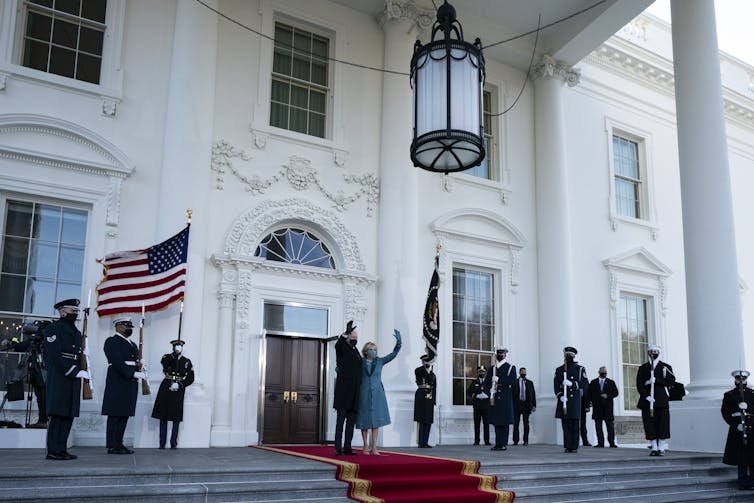
Of course, Biden could quickly reverse the order – and there’s already a bipartisan push to forbid these transfers – but rehiring anyone who has been fired won’t be easy or immediate.
Furthermore, Trump had tried to “burrow” political appointees deep into the senior executive service, the top level of the civil service. The burrowing included the controversial appointment of Michael Ellis as general counsel of the National Security Agency. Senior executive service rules permit some political appointees to be converted to civil servants. This could protect them from easily being removed by Biden.
[Deep knowledge, daily. Sign up for The Conversation’s newsletter.]
Biden may want to remove civil servants considered Trump loyalists who may try to subvert his policies. If so, he’ll have to keep the executive order in place to expedite the process and convert those employees to the new Schedule F classification, which would allow him to remove them. But keeping and using Schedule F, even for a relatively brief period, challenges the most fundamental principles of the civil service.
Trump’s order and Biden’s dilemma show that Teddy Roosevelt’s work is still unfinished. If, on a whim, a president can undo over a century of reforms, then the civil service remains insufficiently insulated from politics and patronage. It may be time Congress passed a new law that permanently shields one of America’s proudest achievements from becoming another dysfunctional part of the U.S. government.
Before you go…
The Conversation is a nonprofit organization, and we depend on readers like you to help us do our important work of sharing ideas and knowledge from academia with the public. Your support keeps us going strong. Your donation will help us reach more people with more research-based journalism. Thank you.



No comments:
Post a Comment